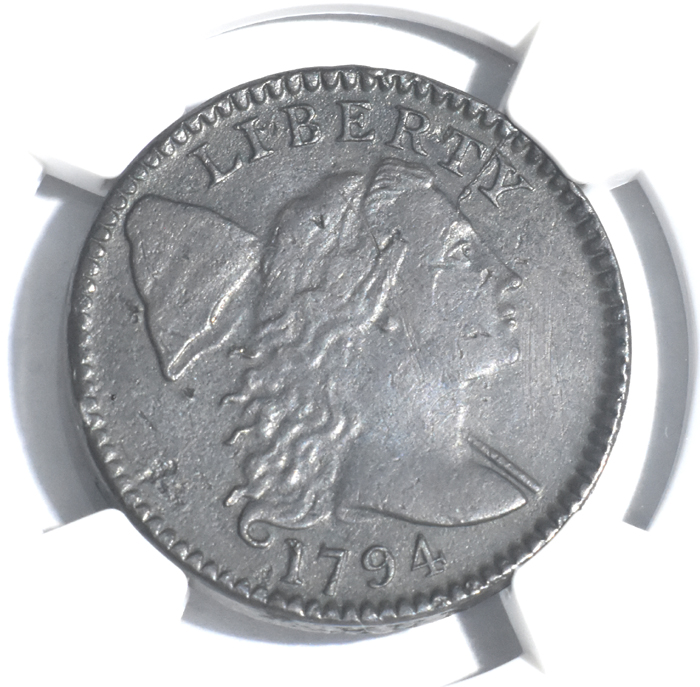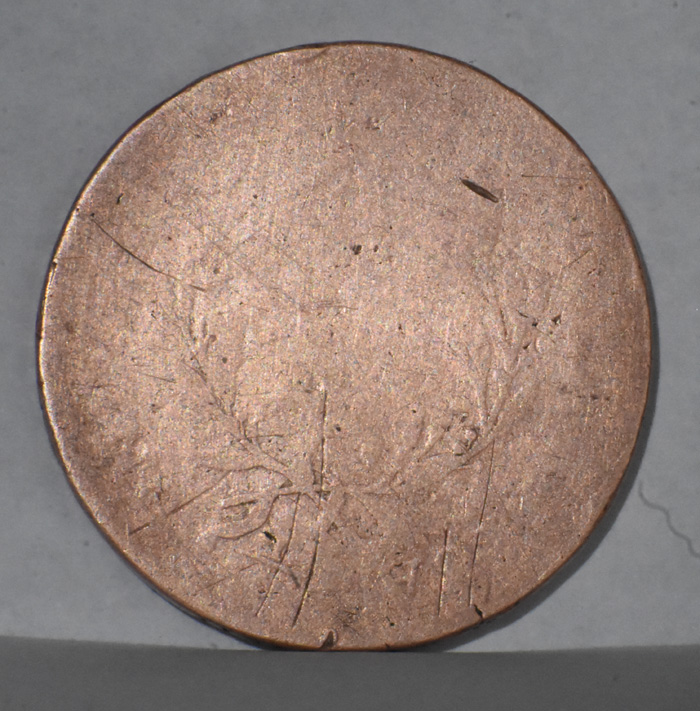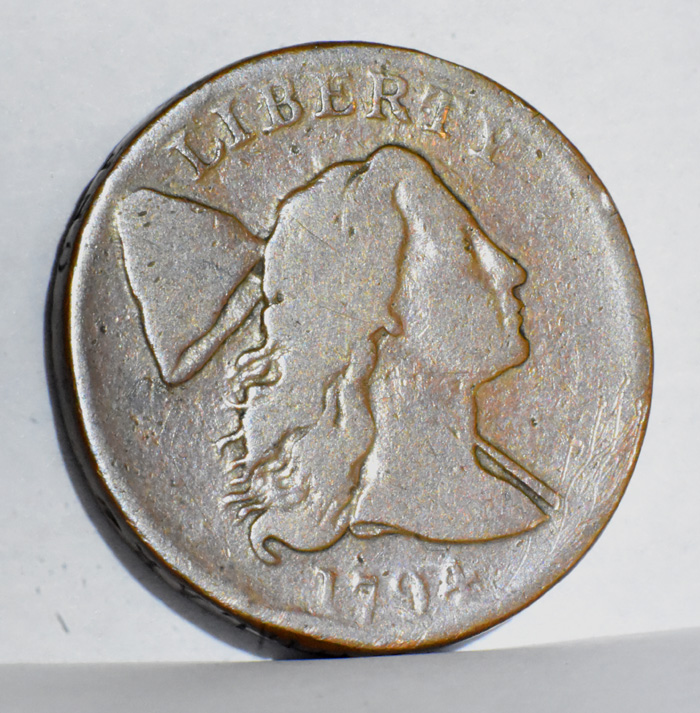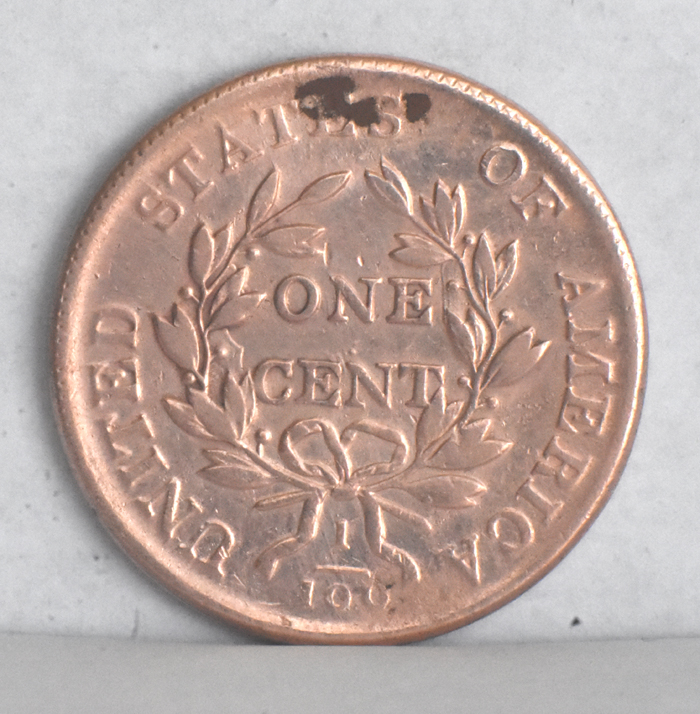





Liberty Cap Cent
1793 - 1796
 |
The very first one cent coins made by the U.S. mint (in Philadelphia) were minted in 1793 and two designs were used, the Flowing Hair and the Liberty Cap. Two different designs of the Flowing Hair cent were made, one with a circle around the words 'One Cent' on the reverse containing a chain within its boundaries, and the other with a wreath in that circle. But only about 36,000 of the chain design were minted and those examples are very expensive, with even an AG coin bringing about $5,000 today. The wreath design was made in a larger quantity, with more than 63,000 having been minted and one of those in AG can be had for about $1600. But it is unlikely that I will ever seek to acquire one of those coins because I have no interest in coins of that grade and the nicer ones are beastly expensive. That same year, the Liberty Cap design was also minted but only 11,056 of those coins were made in 1793. However, the following year of 1794 saw a total of about 918,521 examples made in six different varieties and I have been fortunate enough to find one that fit my budget; it appears at left. Over the 4 years that these coins were made, a total of more than a million and a half were produced. |  |
| This is now one of the two oldest coins I own, being one year older than the Flowing Hair half dollar. This coin was bought specifically for the purpose of being the oldest one I could ever afford without winning the lottery. It cost me $2430 and is slabbed and certified by NGC. This is the version with the head of 1795 and would be worth $8000 if not damaged by the environment because the grade given by NGC is AU. It is stored in SDB 508. | I was sorely tempted to clean this coin because of the dark tarnish but of course, that would lower the value somewhat and on rare coins, this is not a good idea. | |
 |
|
 |
| This coin was bought some years ago when I wanted one of this age and style. It cost me $489 even though the quality was so bad that the reverse is nearly all flat. The coin appears to be of the variety called 1794 with head of 1794 but I cannot be sure without sending it to the experts for grading and certification and the coin was not slabbed and certified when I bought it. After purchasing the one above, I gave this one to Katie, my granddaughter. | It amazes me even now that the crude equipment in use at this time was able to made such a large number of coins in a single year. | This is the reverse of the coin at left. It appears that the coin has been cleaned at some point, although the seller did not say so. The coin was sold as a VG+ but I suspect that it more likely qualifies as an G4 although the reverse side of the coin is not likely to rate even an AG 1. The actual value of the coin is uncertain because none of my price lists have a value for an AG 1 or 2. But if the coin rates a G4 or even an AG 3, despite the poor reverse, it is worth more than I paid for it. |
 |
 |
|
| This is another image of the same coin with some of the color removed so that the date can more easily be seen. | This is what the reverse side of this coin actually looked like before it was worn almost completely off. This one is the reverse of the 1803 Draped Bust cent, which used the same reverse design. |
| 1794: January 13: The U.S. Congress enacts a law providing for, effective May 1, 1795, a United States flag of 15 stars and 15 stripes, in recognition of the recent admission of Vermont and Kentucky as the 14th and 15th states. A subsequent act restores the number of stripes to 13, but provides for additional stars upon the admission of each additional state. February 11: The first session of the United States Senate is open to the public. March 4: The Eleventh Amendment to the United States Constitution is passed by Congress for submission to the states for ratification. March 14: Eli Whitney is granted a United States patent for the cotton gin. March 26: The U.S. lays a 60-day embargo on all shipping to and from Great Britain. March 27: The United States Government authorizes the building of the first
six United States Navy vessels. August 1: Aristocrats in Sweden gather to mourn the demise of coffee after the beverage is forbidden by royal decree. October 4: In the first and only instance of an incumbent United States president leading men into battle, George Washington arrives at Carlisle, Pennsylvania to guide the U.S. Army's suppression of the Whiskey Rebellion. The rebels soon disperse and the insurrection collapses by the end of the month. November 19: The United States and Great Britain conclude the Jay Treaty, the basis for ten years of peaceful trade between the two nations. December 8: The Great New Orleans Fire (1794) burns over 200 buildings in the French Quarter.
|